
|   |

|   |
Guru Shishya Parampara-Gaudiya Nritya - Nita Vidyarthi e-mail: nitavidyarthi@gmail.com Photos courtesy: Ashoke Chatterjee & Mahua Mukherjee April 15, 2020 Gaudiya Nritya Bharati, the pioneering institution of Gaudiya Nritya, presented 'Guru Shishya Parampara' to popularize, propagate and establish their search of the heritage of Bengal through an assortment of the less known dance form of ancient Bengal at Sisir Manch, Kolkata, on the first evening and at the Vivekananda Hall, Ramakrishna Mission Institute of Culture, Gol Park, on the second. The revival of the lost dance form by Prof Dr. Mahua Mukherjee, that is supposed to have existed 2000 years ago in ancient Bengal, was the result of her untiring efforts of 40 years, through extensive research of sculptures, literature, including those which traces the origin of Bengali literature (Chorjapad and Nath Sahitya), oral inputs by artists of rural Bengal, Sanskrit texts and old treatises, inspiring her to regard it as a classical dance form of Bengal. Her support was also more than 25 lectures, the 16 odd number of books written by her, a Fulbright Visiting Professorship in 2004, a number of documentary films in India and lectures in US, Bangladesh and India, the latest being the 'Rabindra Chair' at the Dance Department, University of Dhaka, Bangladesh in 2016. Since then, she is engaged in advancing her academic work and research at the Dhaka University in the Departments of Dance, Philosophy, Pali and Sanskrit. Trained originally in Bharatanatyam, her dance compositions of Gaudiya Nritya is supported by her training in the living traditions of Kushan, Bishahara, Chhau, Baul, Nachni, Raibenshe and kirtan which she has learnt from the existing Guru-Parampara traditions and these were strongly reflected in the two day program. Tandava was the predominant element excepting Rituranga which had a strong component of lasya. She is supported in this direction by her Gaudiya music researcher and vocalist husband, Pt Amitava Mukherjee and Gaudiya dancer and research scholar son Ayan. She is the Director of the Gaudiya Nritya Bharati and Mitrayan. The four-hour long evening at Sisir Manch was exhaustive and a marathon display of the different aspects of this now familiar dance form by dancers, seniors and juniors, including a rewarding solo by Mahua Mukherjee herself. The choreography for all items was by Mahua Mukherjee, vocals and music compositions largely by Amitava Mukherjee, percussions by the internationally renowned khol player Harekrishna Halder with instrumental inputs by Ayan. 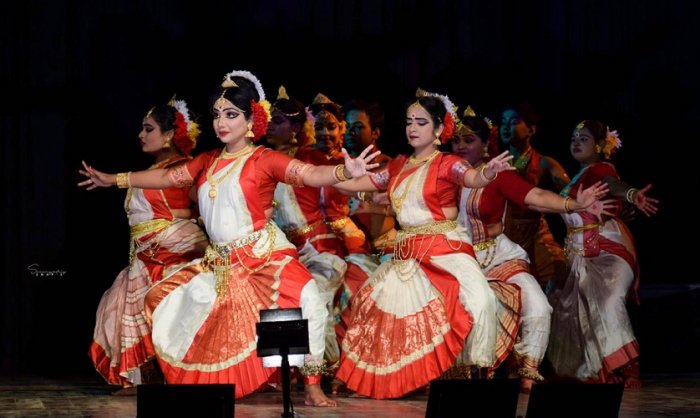 Gaudiya group The 'Ananda Sandhya' began with the chanting of Vedic Mantra for the "Sandhya Vandana". A large number of young learners in red-bordered white saris, adorned with flowers ushered in the evening through "Nrityanga", some basic steps set to an illuminating "Shovam Karapi Kalyanam, Aragyam Dhanasamprada Dipajyoti Namastutey, Dipa Param Brahma Dipajyoti Janardana Namastutey" followed by the everlasting "Asatoma Sadgamaya…" Senior dancer Kaushik Shaw clad in red, began the recitals with "Chandi Vandana", the customary prayer with Kavi Mukundaram Chakravarty's composition. He entered the stage waving a metal (generally silver) mounted yak tail whisk (chamar) on the right hand and an earthenware plate of flowers (Pushpadali) on the left which he placed on the front stage. And the dancing began with the song "Bande Narayani Bhairabi Ma Bhabani". Since Bengal is known to have about 31 out of 51 Sati Pitha or Shakti Pitha, the worship of Shakti is prevalent in Bengal. So in the rural "Gurumukhi" (oral tradition) traditions of songs, music and dance, the influence of Shakta traditions is strong and Chandinritya, Kalikanritya and others occupy an important place in literature like "Chandimangal" Kavya. A glimpse of all this was offered in the energetic presentation of the highly skilled male dancer. Based on the 150 year-old classical kavya by the acclaimed Dwijendralal Roy, one of Bengal's 'Panchakavi', was the well-crafted Birudha Nritya, "Harihar stuti" by Soumya Bhowmick and Paramita Banerjee. With beautifully balanced choreography anchored to Gaudiya sculptures, the contrasting imagery of the two, Hari and Hara, was unfolded with fine coordination by the two seasoned dancers, retaining full discipline. 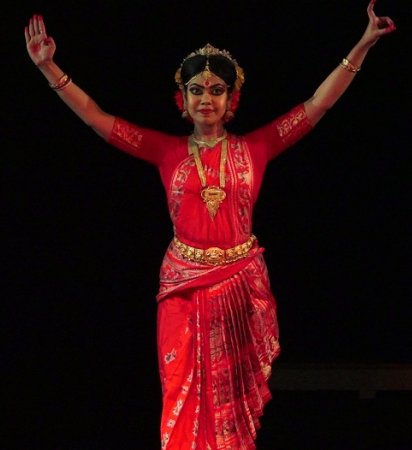 Paramita Banerjee  Satabdi Acharya Satabdi Acharya's physique suited the vigorous dancing in Vyasadeva composed 'Shivashtakam.' A confident dancer, one enjoyed her light-footed jumps and the devotion filled gestures in this item. 'Alapchari' based on Krishnadas' Govindalilamritam stotra was a visually beautiful, rhythmic, sonorous pure dance item, with arithmetical precision, set to sargams by a well-trained group of confident dancers who traced complex movement patterns with the music having a touch of 'kirtananga.' There were glimpses of movements with hastas depicting playing of musical instruments. 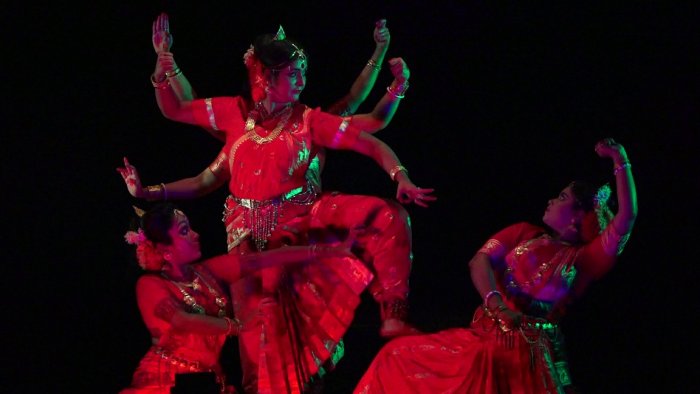 Mahishasura Mardini Five senior mature female dancers, Satabdi Acharya, Paramita Banerjee, Manikiran Duttagupta, Sayantika Majumdar and Rachana Kar offered effective picture of the Divine Principles of Shakti Aradhana in 'Pancha Mahavidya' (Wisdom Goddesses) based on Kalikapuran. The choreography in this piece featuring Kali, Tara, Shodashi, Bhuvaneswari and Kamala was not sophisticated but had the prowess of tantric influence except for that of Vishnuballav Kamala. But still one got to see variations of lovely padabedas and bhramaris like chakra, chauka, tirjak, utpluta and ufli. The music for this piece has a kirtananga tune with the lyrics embellished with subtle alliteration like "Kanak Kamaley Kanaka Barana" (Goddess with golden complexion seated on a golden lotus). It concluded with the revelation of a compelling Mahishasura Mardini by all five dancers. 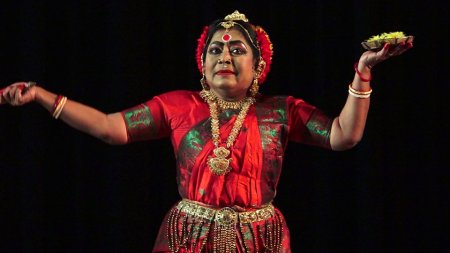 Mahua Mukherjee The much awaited solo by Mahua Mukherjee began following the Gaudiya ritualistic Krishna Vandana, "Hey Krishna Karunasindhu Dinabandhu Jagatpathey" followed by execution on an inverted "Handi" (round earthenware pot) following the Nath Sahitya. It was surprising to see the dancer not lose balance for a split second while executing steadily on it with the mantra "Jaya Jaya Krishna devaya." Durga Mangalacharan based on Durga Saptasadi was dedicated to the dancer's revered Sanskrit guru, the late Manabendu Bandopadhyay and began with the familiar "Jayanti Mangalakali...Chamundi Kalratri Namastutey" followed by "Rupang dehi jayang dehi" from Sri Chandi. The evolution of the theme spiced by her emancipation in "Kali Kali Mahakali Kalikey Parameshwari" followed by a thundering hair-raising laughter, the fearsome movements of the eyes and brows capturing anger (raudra rasa) with incredible kinetic phraseology of tandava body movements were the spirited rigours of her craft that left the viewer shaken with astonishment. Shiva Panchakshara Stotra, "Naagendraharaya" left a lasting impression on the audience with a special mention for the imagery of Lord Shiva drinking the poison. Live accompaniment by Pt Amitava Mukherjee on the vocals, Harekrishna Halder on the mridanga and multitalented Ayan Mukherjee on the sitar enhanced the appeal of Dr. Mahua Mukherjee's rewarding presentation. In the mridanga nritya, Harekrishna Halder of Rabindra Bharati University ruled the stage while supporting the senior students who are yet to have a good grip of the art. The long evening concluded with a group presentation of Rituranga -The garland of seasons interspersing songs and recitations from Tagore with selected slokas from Kalidasa's Ritusamahara. Beginning inevitably with Tagore's "Bishwabina Robey", Kalidasa's "Prachanda Grishma…Taaptapita mohi.." soaked in the notes of strong sitar initiated Grishma and the dancing begins. It was a group item, the usual fare, and a slightly fussy one, moving from one season to another with dancing, recitations, slokas and some uncommon additions of songs like "Kholo kholo dwar" from Tagore ending with "Dakhinoduar khola" for Basanta with the final throwing of flower petals on a joyous note. 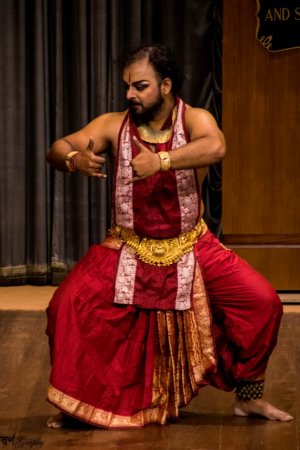 Ayan Mukherjee The second evening of one and a half hours at the Vivekananda Hall was a thoroughly disciplined one in a packed auditorium of mostly seniors. An hour of the power-point presentation by Mahua Mukherjee, reflecting pictures of sculptures, data, pictures in support of the lecture was insightful and also generated further curiosity to know the reconstruction process of the dance form. And it was a healthy one although time was the constraint for detailed interactive sessions. This was followed by a short presentation of the items referred to in the lecture by four consummate male dancers Jayanta Biswas, a young Samarpan Sengupta, Kaushik Shaw and Soumya Bhowmick beginning with a Ganesh Vandana in raag Misra Belawadi, Jhaptaal. The dancing on inverted earthenware plates (sora) embellished with nritta was impressive. A powerful Durga Mangalacharan by Ayan based on 'Durga Satasadi' had Ramprasadi tune and saw the well-groomed dancer cum instrumentalist at his brilliant best. Mandir Nritya produced a tantric ambience. The nritta based item Balaram Alapchari was a part of Narahari Chakravarty's famous text 'Bhakti Ratnakar.' Ardhanarishwar as the Birudha Nritya was a pleasure to watch and so was the concluding Dasavatar in talamalika following the Brihadaranyak Upanishad. The evening concluded with a Shantipath.  Dr. Nita Vidyarthi is a veteran critic of performing arts and writes on dance, music and theatre in leading publications. |